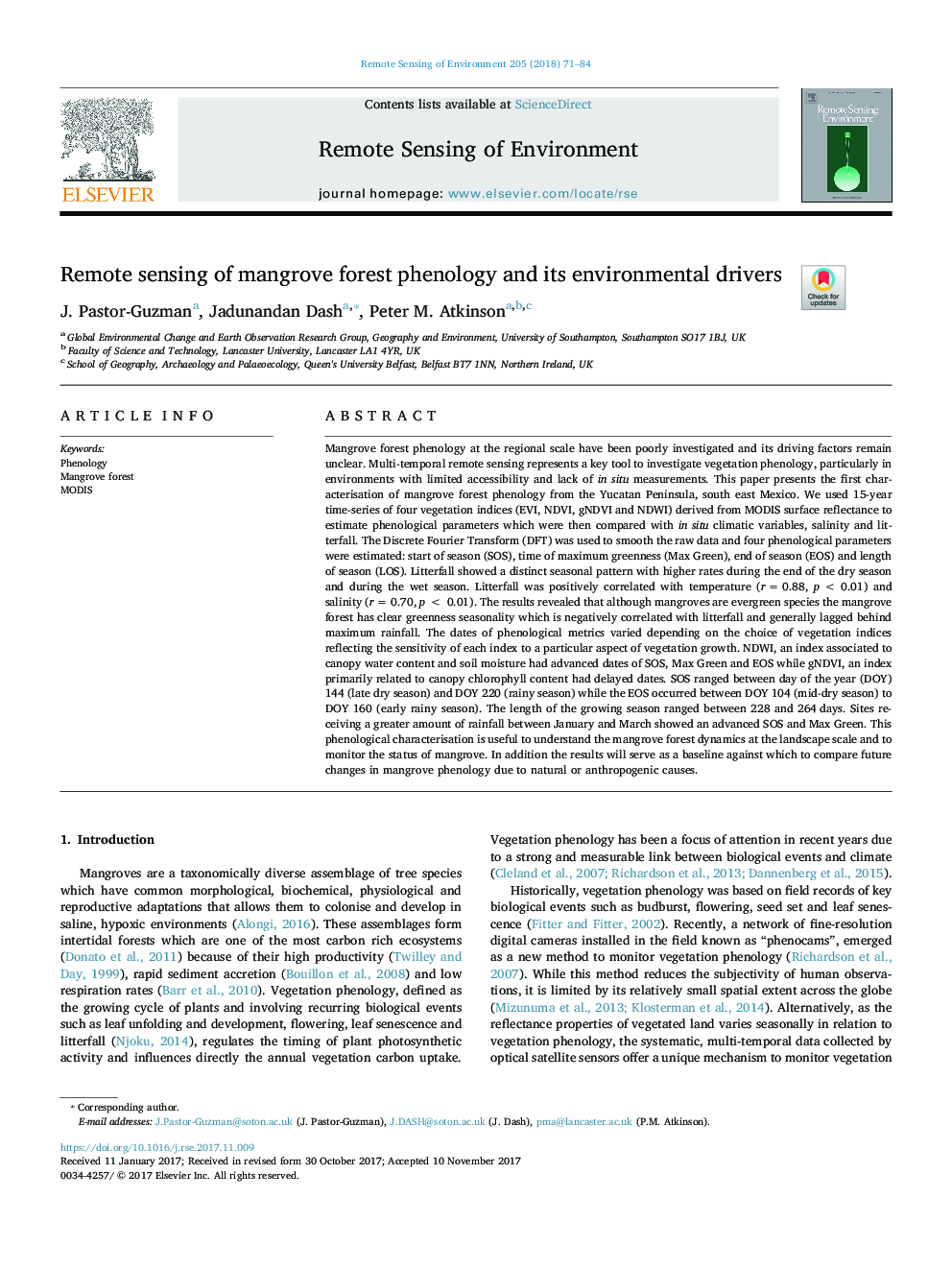| کد مقاله | کد نشریه | سال انتشار | مقاله انگلیسی | نسخه تمام متن |
|---|---|---|---|---|
| 8866766 | 1621195 | 2018 | 14 صفحه PDF | دانلود رایگان |
عنوان انگلیسی مقاله ISI
Remote sensing of mangrove forest phenology and its environmental drivers
ترجمه فارسی عنوان
سنجش از دور از فنولوژی جنگل های جنگلی و رانندگان محیط زیست آن
دانلود مقاله + سفارش ترجمه
دانلود مقاله ISI انگلیسی
رایگان برای ایرانیان
کلمات کلیدی
موضوعات مرتبط
مهندسی و علوم پایه
علوم زمین و سیارات
کامپیوتر در علوم زمین
چکیده انگلیسی
Mangrove forest phenology at the regional scale have been poorly investigated and its driving factors remain unclear. Multi-temporal remote sensing represents a key tool to investigate vegetation phenology, particularly in environments with limited accessibility and lack of in situ measurements. This paper presents the first characterisation of mangrove forest phenology from the Yucatan Peninsula, south east Mexico. We used 15-year time-series of four vegetation indices (EVI, NDVI, gNDVI and NDWI) derived from MODIS surface reflectance to estimate phenological parameters which were then compared with in situ climatic variables, salinity and litterfall. The Discrete Fourier Transform (DFT) was used to smooth the raw data and four phenological parameters were estimated: start of season (SOS), time of maximum greenness (Max Green), end of season (EOS) and length of season (LOS). Litterfall showed a distinct seasonal pattern with higher rates during the end of the dry season and during the wet season. Litterfall was positively correlated with temperature (r = 0.88, p < 0.01) and salinity (r = 0.70, p < 0.01). The results revealed that although mangroves are evergreen species the mangrove forest has clear greenness seasonality which is negatively correlated with litterfall and generally lagged behind maximum rainfall. The dates of phenological metrics varied depending on the choice of vegetation indices reflecting the sensitivity of each index to a particular aspect of vegetation growth. NDWI, an index associated to canopy water content and soil moisture had advanced dates of SOS, Max Green and EOS while gNDVI, an index primarily related to canopy chlorophyll content had delayed dates. SOS ranged between day of the year (DOY) 144 (late dry season) and DOY 220 (rainy season) while the EOS occurred between DOY 104 (mid-dry season) to DOY 160 (early rainy season). The length of the growing season ranged between 228 and 264 days. Sites receiving a greater amount of rainfall between January and March showed an advanced SOS and Max Green. This phenological characterisation is useful to understand the mangrove forest dynamics at the landscape scale and to monitor the status of mangrove. In addition the results will serve as a baseline against which to compare future changes in mangrove phenology due to natural or anthropogenic causes.
ناشر
Database: Elsevier - ScienceDirect (ساینس دایرکت)
Journal: Remote Sensing of Environment - Volume 205, February 2018, Pages 71-84
Journal: Remote Sensing of Environment - Volume 205, February 2018, Pages 71-84
نویسندگان
J. Pastor-Guzman, Jadunandan Dash, Peter M. Atkinson,
